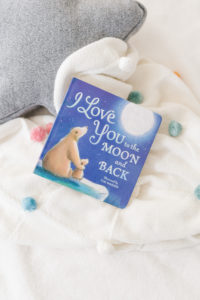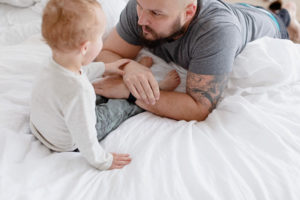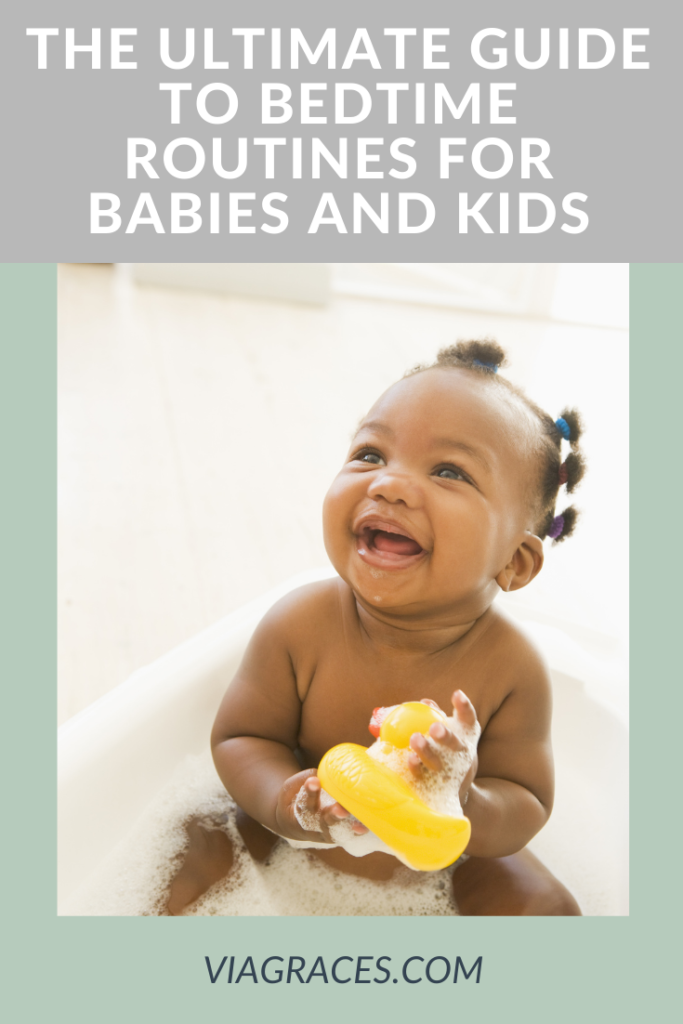Bath Feed Sleep Baby Bedtime Routine
May 17, 2021
The Ultimate Guide to Bedtime Routines for Babies and Kids
When I was first told 3.5 years ago that I should establish a nap and bedtime routine with my baby girl, I was a little overwhelmed.
What would we do? What song should we sing? Would this really matter for a newborn? What if we somehow messed it up?
So Jason and I chatted through what our routine might look like, but to be totally honest, we held very loosely to it for the first several months of Olivia's life. We sometimes sang one verse, we sometimes sang a million verses.
We occasionally threw in a story, but she was often too tired. I would nurse her, but sometimes she would nurse right to sleep, so there just wasn't much consistency.

It wasn't until Olivia was ten months old and we were ready to finally sleep through the night that we tightened up on our routines. And now she's essentially had the same bedtime routine, with a few slight adjustments, over the last three years.
She can walk anyone right through it!
So in this post we'll talk about:
- When to start using a bedtime routine with your baby
- How long your child's bedtime routine should be
- What a newborn's bedtime routine could look like
- How to change your baby's bedtime routine as they get older
- What a toddler and older child's bedtime routine could include
- Why a consistent bedtime routine is so important!
Let's jump in…
When to Start Establishing a Bedtime Routine
The great news is, you can start DAY ONE!
The first night after Avery was born, we swaddled her up and sang our bedtime song as we lulled her to sleep. And so it began!
But if you're reading this and you've never had a consistent bedtime routine, whether your little one is 3 weeks old, 3 months old, or 3 years old, it's never too late to start!
With Olivia, we always had a bedtime song, but it wasn't until she was 10 months old that we really got consistent and stuck to a specific routine.
Just like it's never too late to teach your child to sleep, it's never too late to start a bedtime routine!
You can also change your bedtime routine if what you're doing just isn't working; no one said once you decide on a routine you can't ever change it.
How Long a Bedtime Routine Should Be
Your child's bedtime routine is one of the most important times of the day. The idea behind solid sleep routines is to cue your child's physical body and mind that it's time for sleep.
For naps, this routine should really only last 5-10 minutes before you lay your baby or toddler down. At bedtime, however, I have found that the sweet spot is around 20-30 minutes.
A routine that's much less than 20 minutes may not be enough time for your baby to really register that it's bedtime, and we want to make sure we're cuing their body that overnight sleep is to come.
With toddlers and older kids, we want to also mentally prepare them so that transitioning to sleep isn't such a challenge!
Similarly, anything longer than 30 minutes is often too much for your little one to remember; they will likely forget that bedtime is even happening!
If you have a newborn and you are still establishing feeding and each feed is still taking 20+ minutes, note that their bedtime routine will likely be longer than 30 minutes. And that's okay if it's the feed piece that makes it longer!
Where the Bedtime Routine Should Take Place
I suggest the bedtime feeding take place in your living room – somewhere with bright lights, some stimulation, and somewhere that feels set apart from sleep.
If you want to feed your baby in their room, maybe because older siblings are running around the living room and it's too distracting, just make sure to keep the lights bright and stimulation high! If the end goal is independent sleep, we don't want your baby using this feed to get drowsy or to completely fall asleep.
Then once your child has taken a bath and brushed their teeth, try to finish out the rest of the routine in their room to help them continue to physically and mentally prepare for sleep.
Here are my suggestions for bedtime routines according to your child's age:
Newborn Bedtime Routine (0-3 months old)
Example Newborn Bedtime Routine:
- Bath/wash hands, feet, face
- Diaper
- Feed
- Lotion and jammies
- Swaddle
- Song

I want to point out a few "why"s in this newborn bedtime routine:
First, you'll see that I have the bedtime feed between the diaper and jammies. The purpose of this is one, to help you find some extra space to enjoy some skin-to-skin time with your baby, if that's something you're being intentional about.
And two, feeding your newborn in just a diaper also helps them stay awake so they can get in a nice and full feeding without falling asleep!
You may need to tickle your baby's toes, blow on their face, stroke their cheeks, etc, to help keep them stimulated, and doing all of this before they're extra warm and cozy in their jammies is really helpful.
You'll also see that this routine includes swaddling your newborn. I highly recommend parents of newborns swaddle their babies the first several weeks of life to help prevent the Moro, or startle reflex!
And then between 8-12 weeks, transition your baby out of the swaddle, either into a more standard sleep sack or just jammies.
Finally, I want you to note that your newborn will still need help getting to sleep! While we can absolutely start establishing sleep habits from the start, newborns still need quite a bit of comfort and support getting there.
Baby Bedtime Routine (4-12 months old)
Example Baby Bedtime Routine:
- Feed
- Bath/wash hands, feet, face
- Diaper, lotion, and jammies
- Sleep sack
- Read one-two books
- Song
Now to point out a few "why"s in this baby bedtime routine and how it's different than a newborn's bedtime routine:
One of the biggest differences between newborn and baby bedtime routines is when the feed takes place in the routine.
Around 3-4 months, I suggest parents move the feed to the very first step of the bedtime routine, even before the bath.
The main reason we do this is to make sure your baby is not trying to use the breast or bottle to fall asleep, or even get drowsy before you lay them down.
Although laying your baby down "drowsy but awake" can be helpful in newborn world, once babies go through the four month regression and their sleep cycles mature into being more adult-like, "drowsy" is now the first step into their sleep cycle, and laying them down drowsy will likely cause further sleep challenges.
You'll also notice that I love ending bedtime routines with a song; we have done this with both of our girls since day one!
When choosing a song to sing, try to pick a song that you can sing in about 30 seconds, or just pick one verse. Because although singing and cuddling your babe as the last step in your routine is so so sweet, we want to watch that they are not getting drowsy in that last step before lying them down in their crib.
Finally, I want to point out that we are no longer swaddling babies at this age, but I am a big fan of sleep sacks! Read more about why I love sleep sacks and what my favorites are here.
Older Baby and Toddler Bedtime Routine (12 months-3 years old)
Example Older Baby & Toddler Bedtime Routine:
- Bath/wash hands, feet, face
- Diaper, lotion, and jammies
- Sleep sack
- Read two books
- Song

Now to point out a few "why"s in this older baby and toddler bedtime routine and how it's different than the newborn and baby routines:
The biggest change is that a feed is no longer part of the bedtime routine.
It doesn't have to be at 12 months on the dot, but it's around this age when babies should now be consuming solids as their main source of nutrients, and any form of milk is an added bonus.
Just like adults don't need to end the night with a glass of milk or snack, the end goal is that our baby or toddler's last milk of the day ends with dinner.
You'll also see that I still have a sleep sack in this bedtime routine. I am a huge fan of sleep sacks and both of my girls (1.5 and 3.5) still wear one to sleep, but know that sleep sacks are not required to have great sleepers.
Older Child Bedtime Routine (3 years and older)
Example Older Child Bedtime Routine:
- Bath/wash hands, feet, face
- Jammies and affirmations
- Read one chapter or two books
- Massage
[Get a free printable bedtime routine chart here!]
Now to point out a few "why"s in this older child's bedtime routine and how it's different than the newborn, baby, and toddler routines:
As kids get older, they often start gaining more fears when it comes to bedtime, or they struggle to really settle in bed for the night (especially after transitioning from a crib to an open bed!).
I encourage parents to include some sort of affirmation, a quote, a Bible verse, etc, in their older child's bedtime routine to help them think more positively about bedtime.
I also encourage parents to finish the routine with some sort of massage, as it's a great way to give your child that final grounding in their bed before you leave for the night.
Just remember not to rub their back for so long that they're once again getting drowsy or even falling asleep before you leave the room!
Finally, I want to note that it's okay for your child's bedtime routine to be fun. This is the last time of the day you have to really connect with your little one, so if that means having a bubble bath, or wrestling while getting jammies on, or singing silly songs while brushing teeth, that's all okay!
And if your little one fights to get through the bedtime routine, consider using a visual schedule to give them more independence over it!
Should I Give My Baby a Bath Every Night?
I always encourage parents, whether they have a newborn, baby, toddler, or school-aged child, to start the bedtime routine with a bath.

And if it's not bath night, splashing your child's face with water/using a wash cloth, washing their hands, and running their little feet under the warm sink is second best!
Why?
First, we're not generally bathing our kids all day long, so having a bath is a great way to establish that something different is happening; this is not just another part of the day, this is bedtime. And we want our kids' bodies and minds to register this!
Second, as melatonin (our body's natural sleepy hormone) starts producing at night, our body temperature also starts declining; this is helpful to prepare us for sleep. And our body temperatures tend to lower after a warm bath, so starting bedtime routines that way helps our bodies continue what they're already naturally doing, preparing us all the more for sleep.
(This also means that baths or showers are helpful for adults before bed, too!)⠀
Conclusion
Your little one's bedtime routine is one of the most important parts of the day, and it's also a really sweet time to connect before you go your separate ways for the night.
We want bedtime to be predictable for your child and also repeatable by anyone who puts your kiddo to bed, so keep that in mind when planning what your bedtime routine will look like.
If you're reading this and don't have a nap or bedtime routine, it's not too late to start! Decide on what you'd like to do and in what order, start it tonight, and stick to it!
And before you know it, your child will pick up on it (even those newborns!) and will be able to predict what's coming…SLEEP!
With Grace,
Lauren

Source: https://viagraces.com/bedtime-routine/
0 Response to "Bath Feed Sleep Baby Bedtime Routine"
Post a Comment